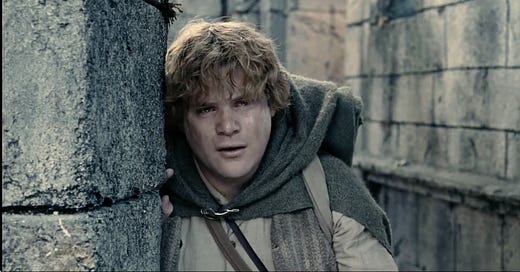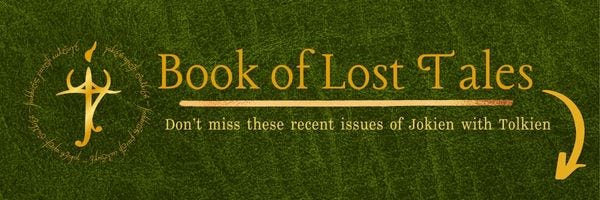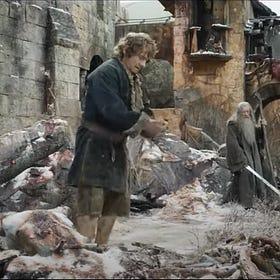End with the Gritty Middle
The Two Towers, Holy Friday, and the good worth fighting for
Mae govannen, friends! Josh here with a guest post for you today from MaryAnn McKibben Dana, a Jokien with Tolkien subscriber who wrote about what she took away from seeing The Lord of the Rings trilogy in theaters recently last year.
MaryAnn McKibben Dana is a writer, speaker, leadership coach, and mother of three young adults. She’s the author of three books, most recently Hope: A User’s Manual, with another on the way next year, and she writes weekly here on Substack at The Blue Room. She’s also an amateur improviser, an imperfect knitter, and an occasional ultramarathoner. Ask her about her Lord of the Rings tattoo!
End with the Gritty Middle
The Two Towers, Holy Friday, and the good worth fighting for
When I heard Peter Jackson’s The Lord of Rings trilogy would be re-released in theaters for a single weekend last June, I hurried online to get tickets. But there was a problem: I had a scheduling conflict on the original date of The Two Towers. This was especially galling because The Two Towers is my favorite of the three films.
As luck would have it, the theaters extended the run for another weekend, but this time I had conflicts in the opposite direction—free for the second installment, conflicts for one of the others. And that’s how I came to watch The Fellowship of the Ring, then The Return of the King the first weekend, and The Two Towers later that month as the “finale.”
In retrospect, I wouldn’t have it any other way.
For me, and for many of us who love this trilogy onscreen and on the page, the stories are a touchstone, full of quotes and scenes that speak to hope and perseverance despite everything. And yes, there’s something deeply satisfying about that final movie—the ultimate triumph of good over evil, despite what it costs some of our heroes. Return of the King provides a decisive conclusion—actually many conclusions, as fans of the films like to chuckle about. Jackson isn’t just ending a film, but a trilogy, and let’s just say he takes his time and does it right. There can be no doubt that this saga is over. This week, Christians around the world are preparing for the great feast of Easter, that glorious reminder that, as Frederich Buechner puts it, the worst thing is never the last thing. This very publication has connected Easter with Tolkien’s idea of eucatastrophe: the “sudden joyous turn in a fairy-story.”
But here in our world, when so much is not as it should be, what’s powerful to me is the gritty middle, when the work of wholeness still sits on our collective shoulders. There’s so much to do: people to protect and letters to write and community to be built and kids to care for and strangers to learn to trust, and ultimate victory still eludes us in many ways. The story of the resurrection, I’ve heard it said, isn’t really a conclusion but a new beginning… not an answer to a question, but a whole new set of questions: What does it mean to live as if new life is really real? For what, exactly, are we set free? How does the “already” of Easter nourish us for the “not yet” of our present challenges?
Those themes are present in Christ’s story even before we get to the empty tomb. In the hours before Jesus’ arrest and crucifixion, an unnamed woman comes and anoints his head with expensive oil. His disciples scoff at her extravagance; after all, the oil could have been sold and the proceeds used to help those in need. Jesus praises the woman for doing a beautiful thing for him and chastises the naysayers, saying, “you always have the poor with you . . . but you will not always have me.” The verse has vexed justice-hearted people for centuries. But Jesus isn’t throwing up his hands and saying that poverty is inevitable, so what’s the point. He’s saying, “You’ll never not have work to do, so plan accordingly.”
Narratively, I see this dynamic as an example in medias res, Latin for “in the middle of things”: the idea that we’re dropped in the midst of a story already underway, in which definitive beginnings and endings are elusive. Consider the beginning of Star Wars: Episode IV – A New Hope, which opens immediately with an action scene in which imperial forces have boarded Princess Leia’s ship as she launches vital Death Star plans and two droids into an escape pod. Or The Sopranos’ famous cut to black in the series finale, so jarring to original audiences that many thought their televisions had malfunctioned.
In medias res is where we live our lives, and that’s what makes The Two Towers such a powerful volume of the story. Here’s where Sam utters his famous speech, those soaring words that ring out at the absolute bleakest point in the narrative.1 Sam reminds us that the great stories are full of ordinary people who could have given up but kept going, not because success was assured, or even likely, but because they believed the good was worth fighting for. Watching the trilogy last June and ending it with Sam’s words was galvanizing indeed—not so much a cliffhanger as a call to action while danger continues to lurk in too many places.
Even the score hints at in medias res. The piece that plays under Sam’s speech is called Samwise the Brave, and it’s a stirring accompaniment to his words. The orchestra soars… until the last forty-five seconds of the track, when the music dramatically charges tone to something menacing, something sinister on the prowl. This bit plays in the film underneath Gollum’s plot to lead Sam and Frodo into Shelob’s lair, which is where The Two Towers ends. This abrupt shift in the score raises the stakes for our heroes; Frodo and Sam have a renewed will and the courage to press on, but they don’t know what lies ahead.
Nowhere is the tenuousness of in medias res more evident than during the Battle of Helm’s Deep. Aragorn and Théoden have made the decision to ride out and meet the Uruk-hai, against whom the people of Rohan are hopelessly outmatched. They ride out “for death and glory” as the horn of Helm Hammerhand sounds “one last time.”
As Théoden and Aragorn ready the charge, Gimli says, “The sun is rising,” and the camera cuts to a slender window and a small shaft of light. And here’s where this near-perfect trilogy of films makes what I see as its one thematic misstep: we hear Gandalf’s voiceover, “Look to my coming on the first light of the fifth day, at dawn; look to the East.”
On the one hand, I understand the choice to share that voiceover, because you can’t count on the audience to remember Gandalf’s parting words as he rides out of Edoras. But what if those words were not top of mind for our warriors? Which option displays more courage: for our heroes to ride out, assured that the wizard will return with reinforcements in the nick of time… “precisely when he means to”? Or for them to bravely confront a seemingly unbeatable foe because it’s the right thing to do, even when they’re not feeling assured or hopeful of Gandalf’s return?2
As a pastor, I’ve often wished the congregations I serve could have an experience of collective amnesia on Holy Thursday and Good Friday. As we march through the drama of Holy Week, we always know that Sunday’s coming—that the eucatastrophe is secure. But what would it be like not to know this?
Having the end of the story firmly in mind can be a comfort. But with the outcome assured, with a confident voiceover echoing in our ears and our Easter bonnets and pastel neckties at the ready, we can hold the uncertainty of in medias res at arm’s length. It’s hard for us to put ourselves in the place of those first disciples, who abandoned, denied and then buried the leader of their movement without knowing another chapter was coming.
Imagine believing you’ll never see the teacher again.
Imagine wondering: Were we wrong this whole time?
And then having to make a decision: Will we carry on anyway?
As the world continues to yearn for justice, as we live in a meantime in which all is not yet right, I wonder sometimes whether focusing on a happy ending allows us to gloss over the work of what John Lewis called “good trouble,” even if our efforts don’t ultimately amount to much.
So this Easter, I’d like to encourage all of us to not skip to the eucatastrophe but instead “end with the middle.” Before rushing to the empty tomb, sit in the weight of Good Friday and consider the work that remains before us.
Like me ending my recent rewatch of The Lord of the Rings trilogy with The Two Towers, ending with the middle reminds us that the “good worth fighting for” means we do what’s right and true, here where we are… even if we aren’t sure whether Gandalf will appear over that ridge. Because the good in the world is worth fighting for whether we know how it will turn out or not.
Hey! Thanks for reading! Did you like this post? Then why not subscribe to MaryAnn's Substack, The Blue Room, to get more like it straight to your inbox?New Life, In Defiance of Death
There’s a scene from The Hobbit: The Battle of the Five Armies that Peter Jackson left on the cutting room floor that I mulled over for weeks after I first saw it.
Appendices
Just last week The Hollywood Reporter revealed as an aside in an article about the revival of Dire Wolves that Peter Jackson was the mystery bidder who purchased the prop of the Iron Throne from Game of Thrones for $1.49 million last year!
Special thanks to Sharon C and Renee for becoming paid subscribers this month! If you too want to help support this newsletter get bonus content, consider upgrading today for just $5 a month or $40 a year!
Interested in writing a guest piece like the above? Check out my submission guidelines.
📚 You can read more of my writing by reading my books! My latest is a collection of essays on The Lord of the Rings, The Silmarillion, and more of Tolkien’s works (and their adaptations). You can also find it and more of my books on Amazon or Gumroad
⚔️ If someone forwarded this email to you or you found it through social media or Google, I’d like to invite you to join 12,000+ subscribers in the Jokien with Tolkien community: Subscribe here and get a free gift just for joining!
🏹 Chosen as a Substack Featured Publication in 2023
🪓 Official merch available in the Jokien with Tolkien store
❌ All typos are precisely as intended
🔗 Links may be affiliate, which is a free-to-you way to support this newsletter where I earn a small commission on items you purchase
🗃️ Can’t wait till next week for more content? View the archive
🤝 Want to sponsor a future issue of Jokien with Tolkien? View my rates and packages
Editor’s Note: though portions of the speech are based on Sam and Frodo’s discussion on in “The Stairs of Cirith Ungol,” the film version is as much Peter Jackson, Fran Walsh and Philippa Boyens' distillation of themes in Tolkien as it is Tolkien. But that doesn’t make it any less powerful or poignant! It’s easily the best thing to come out of the less-successful change of having Faramir take Frodo and Sam to Osgiliath. You can read a bit more about it here in this Tolkien Gateway article,
Editor’s Note: the specifics in Gandalf’s memorable words to “Look to my coming, at first light, on the fifth day. At dawn, look to the East” (‘at first light', on the fifth day’ and ‘at dawn’ and ‘the East’) are all inventions/embellishments of the film. In the book, he simply says “‘Ride, Théoden! Ride to Helm’s Deep! Go not to the Fords of Isen, and do not tarry in the plain! I must leave you for a while. Shadowfax must bear me now on a swift errand.’ Turning to Aragorn and Eomer and the men of the king’s household, he cried: ‘Keep well the Lord of the Mark, till I return. Await me at Helm’s Gate! Farewell!” So they know he intends to return, but not when, which makes Théoden’s decision to ride out even more courageous and noble.











A beautiful reflection and great way for me re-center on the meaning of this week. I'd never considered how the movie would change if they took out that voiceover from Gandalf but I have to agree! It reminds me of this wonderful quote in N. D. Wilson's "Dandelion Fire": "Sometimes standing against evil is more important than defeating it. The greatest heroes stand because it is right to do so, not because they believe they will walk away with their lives. Such selfless courage is a victory in itself.” Thank you for this reminder.
"I wonder sometimes whether focusing on a happy ending allows us to gloss over the work of what John Lewis called “good trouble,” even if our efforts don’t ultimately amount to much.
"So this Easter, I’d like to encourage all of us to not skip to the eucatastrophe but instead “end with the middle.” Before rushing to the empty tomb, sit in the weight of Good Friday and consider the work that remains before us."
What a wonderful, compelling thought-- perfect for Holy Week. I enjoyed this post tremendously-- thanks so much for sharing!!